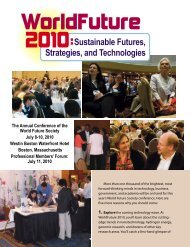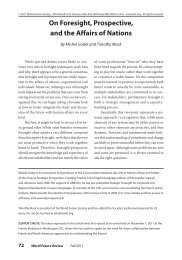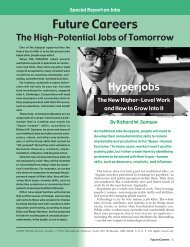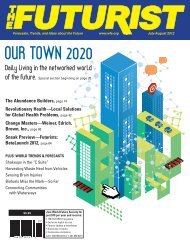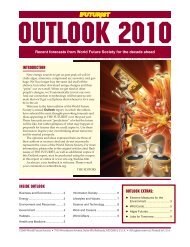52 Trends Shaping Tomorrow's World - World Future Society
52 Trends Shaping Tomorrow's World - World Future Society
52 Trends Shaping Tomorrow's World - World Future Society
You also want an ePaper? Increase the reach of your titles
YUMPU automatically turns print PDFs into web optimized ePapers that Google loves.
of revenues. Corporate R&D in theUnited States has shifted in recentyears, with less emphasis on pharmaceuticalsand computer-relatedfields and more focus on biotechnology,nanotechnology, and securitytechnologies.• China has taken second place inthe world’s R&D spending, with abudget estimated at $136 billion in2006, up from $60 billion in 2001.Still more spending may be hiddenin military budgets. China says itwill raise its R&D spending fromabout 1.23% of GDP in 2004 to 2.5%in 2020. In 2008, it spent 40% moreon R&D than the year before. China’soutput of research papers increasedfrom just over 20,000 in 1998 tonearly 112,000 in 2008. It passedJapan, Germany, and the UnitedKingdom in 2006. A study by the EuropeanUnion predicts that Chinaand India will lead the world in R&Dby 2025.• R&D outlays in Japan have risenalmost continuously, to nearly 3.5%of GDP. In 2007, Japan spent about$148 billion on R&D. In 2008, itsR&D spending grew by 4.4%.• R&D spending by the top 350companies in the European Unionamounted to $170 billion in 2008, up8.1% in a year.• In Russia, government R&Dfunding amounted to about $53 billionin 2008, approximately 60% oftotal research funding in the country.Some 44% of Russia’s R&D budgetgoes to defense research, 10% tospace. These figures omit whateverclandestine military research escapesnotice. Owing to the global recession,however, Russia’s research budgetfaced planned cuts of 30% in 2009.• Western corporations are outsourcinga growing fraction of theirR&D to foreign contractors, just asthey do other functions. Much of thiswork goes to India, some to Russiaand eastern Europe, but the growtharea is China.Assessment and Implications:This is a significant factor in the accelerationof technological change.The demand for scientists, engineers,and technicians will continueto grow, particularly in fields whereresearch promises an immediatebusiness payoff.Low-wage countries such as Chinaonce took only low-wage jobs fromadvanced industrialized countries.Today, higher-paid jobs in science,technology, and the professions alsoare at risk.Countries like India, China, andRussia once suffered a brain drain asthose with high-tech skills emigratedto high-demand, high-wage destinations.Today, many students and professionalsspend time in the West tolearn cutting-edge skills, and then returnto their native lands to work,start companies, and teach. This promotesthe growth of some developingcountries while reducing thecompetitive advantages of the developedworld.n 5Services are growing fasterthan any other sector of theglobal economy.• Service jobs have replaced manyof the well-paid positions lost inmanufacturing, transportation, andagriculture. These new jobs, oftenpart time, pay half the wages ofmanufacturing jobs. On the otherhand, computer-related service jobspay much more than the minimumfor workers with sound educationand training. Medicine, the law, andmany other well-paid occupationsalso fall into the service sector.• Service industries provide morethan 79% of the GDP in the UnitedStates, 77% in France, 74% in Britain,73% in Japan, and 70% in Germany.In each case, services are growingrapidly; other sectors, less so.• Service industries account forabout 77% of private nonfarm employmentin the United States, upfrom 70% in 1990. Services accountedfor the entire net gain in U.S. privateemployment in the decade ending2010.• In Britain, services provide 80.4%of jobs; in France, 72%; in Japan, 68%;in Germany, 64%. In each case, thepercentage of service employment isrising.• In contrast, services in Chinaprovide only 40.5% of GDP and 33%of employment. In India, they accountfor 63% of GDP and perhaps35% of jobs. (Sector employmentdata for India are extremely dated.)• In the decade ending in 2016,service industries will provide 15.7million new jobs, according to theU.S. Bureau of Labor Statistics (BLS).• Education and health serviceswill add 5.5 million jobs, more than30% of all new jobs expected for theperiod. Employment in professional,scientific, and technical services willgrow by 28.8% and add 2.1 millionnew jobs by 2016.• Production and less-skilled jobs,in contrast, are disappearing. By2014, the United States is expected tohave more chief executives than machinetool operators, more lawyersthan farm workers.• Meeting the BLS estimate of 15.7million new jobs by 2016 would requirethe creation of some 300,000jobs every month from November2009 on. This assumes that it is necessaryto make up the 8.4 millionjobs that the official numbers sayhave been lost since the recession began.It omits 10 million or morepeople who either have given uplooking for work or have settled forpart-time employment.Assessment and Implications:This trend is helping to deplete themiddle class, as well-paid jobs inmanufacturing are replaced by illpaidservice positions, leaving acountry of “have lots” and “havenots,” but relatively few “haveenoughs.”Services are now beginning tocompete globally, just as manufacturingindustries have done over thelast 20 years. By creating competitivepressure on wages in the industrializedlands, this trend will help tokeep inflation in check.The growth of international businesswill act as a stabilizing force inworld affairs, as most countries findthat conflict is unacceptably hard onthe bottom line.n 6Job creation is ceasing toprovide employment for allwho need it.• According to official estimates, ittakes 100,000 jobs per month to absorbyoung people and others justentering the labor force. BetweenJanuary 1999 and October 2009, theU.S. economy generated an averageof only 26,000 jobs per month.• Most economists believe it willtake five years—that is, to 2015—just4 • <strong>52</strong> <strong>Trends</strong> <strong>Shaping</strong> Tomorrow’s <strong>World</strong>




